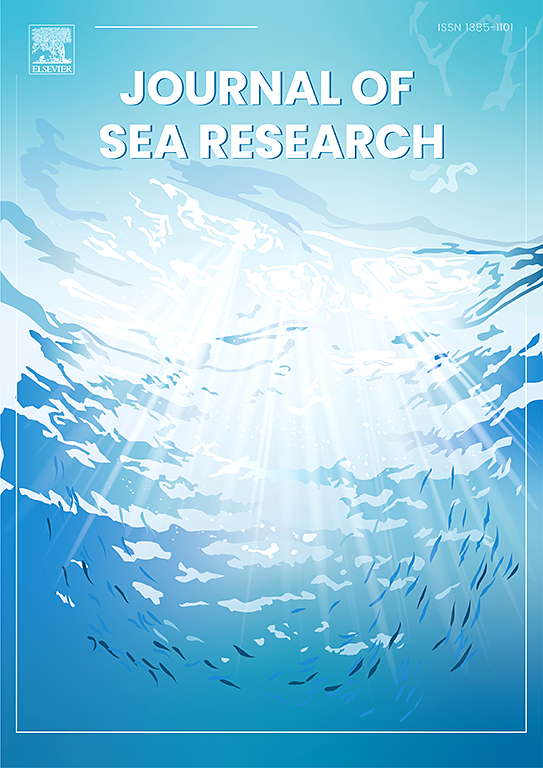Eutrophication-driven biogeochemical processes influencing dissolved organic matter dynamics in a tropical coastal bay: Insights from Lianzhou Bay, northwestern South China Sea
IF 2.9
4区 地球科学
Q2 MARINE & FRESHWATER BIOLOGY
引用次数: 0
Abstract
The global understanding of coastal carbon cycling is increasingly recognising the disproportionate importance of small estuary-coastal bay systems. This study analysed dissolved organic carbon (DOC) and nitrogen (DON), coloured and fluorescent dissolved organic matter (DOM, CDOM and FDOM), along with environmental parameters in Lianzhou Bay, northwestern South China Sea, during summer 2022. A two-endmember mixing model was applied to quantify the non-conservative (Δ) dissolved inorganic nitrogen (DIN), phosphorus (SRP), and DOM. DIN decreased linearly with salinity, suggesting conservative mixing, while SRP showed no salinity dependence and was elevated nearshore, suggesting anthropogenic inputs. Non-conservative additions of DOC (44 %), CDOM (31–44 %), and protein-like FDOM (FDOMP, 46 %) were accompanied by substantial DON removal (−83 %). ΔDOC and ΔCDOM were negatively correlated with chlorophyll-a, suggesting their origin from the early microbial transformation of phytoplankton-derived particles. Conversely, the positive correlation between ΔDON and chlorophyll-a, together with a negative ΔDON–ΔDIN correlation of differing magnitudes, suggests partial microbial utilisation of N-rich compounds, with nitrogen not fully retained as DIN. Regionally, CDOM accumulated in the middle bay with minimal ΔDOC, driven by microbial processing of biogenic particles; the southern bay showed zero ΔDOC but positive ΔFDOMP, suggesting coupled production and degradation; in the north, excess primary production led to DOC buildup and DON removal, with labile DOM actively utilized. Among Chinese bays, the relatively low FDOMP proportion in Lianzhou Bay, despite high DOM levels, reflects limited direct anthropogenic inputs and substantial microbial humification, highlighting the complex interplay of natural and human-driven processes shaping coastal DOM composition.
富营养化驱动的生物地球化学过程对热带沿海海湾溶解有机质动态的影响——来自南海西北部连州湾的观察
全球对沿海碳循环的认识日益认识到小型河口-沿海海湾系统的不成比例的重要性。本研究分析了2022年夏季南海西北部连州湾海域溶解有机碳(DOC)和氮(DON)、彩色和荧光溶解有机质(DOM、CDOM和FDOM)以及环境参数。采用双端元混合模型定量非保守性(Δ)溶解无机氮(DIN)、磷(SRP)和DOM。DIN随盐度线性下降,表明混合较为保守,而SRP不受盐度影响,且在近岸升高,表明人为输入。非保守添加的DOC (44%), CDOM(31 - 44%)和蛋白样FDOM (FDOMP, 46%)伴随着大量的DON去除(- 83%)。ΔDOC和ΔCDOM与叶绿素-a呈负相关,表明它们起源于浮游植物衍生颗粒的早期微生物转化。相反,ΔDON与叶绿素-a之间的正相关,以及不同程度的负相关ΔDON -ΔDIN,表明微生物对富氮化合物的部分利用,氮没有完全保留为DIN。从区域上看,CDOM以极小的ΔDOC聚集在中部海湾,主要受生物成因颗粒的微生物作用驱动;南湾为0 ΔDOC,但为正ΔFDOMP,表明生产和退化耦合;在北方,过量的初级生产导致DOC的积累和DON的去除,不稳定的DOM被积极利用。在中国的海湾中,连州湾的FDOMP比例相对较低,尽管DOM水平很高,但反映了有限的直接人为输入和大量的微生物腐殖化,突出了自然和人为驱动过程形成沿海DOM组成的复杂相互作用。
本文章由计算机程序翻译,如有差异,请以英文原文为准。
求助全文
约1分钟内获得全文
求助全文
来源期刊

Journal of Sea Research
地学-海洋学
CiteScore
3.20
自引率
5.00%
发文量
86
审稿时长
6-12 weeks
期刊介绍:
The Journal of Sea Research is an international and multidisciplinary periodical on marine research, with an emphasis on the functioning of marine ecosystems in coastal and shelf seas, including intertidal, estuarine and brackish environments. As several subdisciplines add to this aim, manuscripts are welcome from the fields of marine biology, marine chemistry, marine sedimentology and physical oceanography, provided they add to the understanding of ecosystem processes.
 求助内容:
求助内容: 应助结果提醒方式:
应助结果提醒方式:


